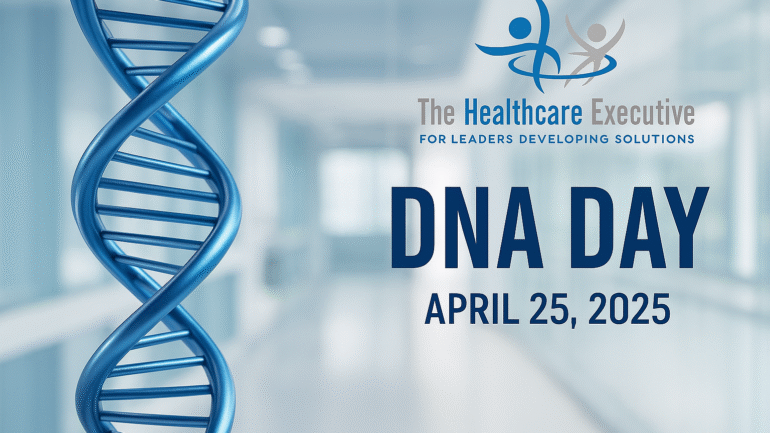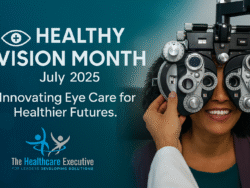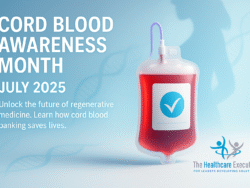DNA Day 2025: How Executive Leadership Shapes the Future of Genomic Care | April 25, 2025

- Posted by Greg Wahlstrom, MBA, HCM
- Posted in Health Observance Calendar
DNA Day 2025: Executive Strategies for Integrating Genomics into Health System Leadership
Published: April 25, 2025
DNA Day, recognized annually on April 25, honors the groundbreaking discovery of DNA’s double helix structure and highlights the continued advancements in genomic science. For healthcare executives, this observance isn’t just about commemorating history—it’s a strategic opportunity to examine how genomics is transforming personalized medicine, precision diagnostics, and data-informed clinical pathways. Institutions like Mayo Clinic have led the way in integrating genomic testing into mainstream care, significantly improving outcomes for oncology and rare disease patients. At the administrative level, genomic data demands modern infrastructure, robust data governance frameworks, and ethical standards around patient privacy and informed consent. Executives who champion these innovations not only future-proof their organizations but also build trust among clinicians and the public. As costs decline and adoption widens, genomics will no longer be a fringe specialty but a core driver of care quality. Forward-looking leaders must anticipate regulatory shifts, engage with cross-functional teams, and invest in workforce readiness. To do so requires not just awareness of genetic science, but a board-level strategy that aligns with broader value-based care goals. In this new era, the C-suite must act as bridge builders between scientific progress and clinical application. GenomeWeb recently projected a 20% annual growth rate in genomic testing markets—highlighting the financial implications for health systems. Consequently, strategic planning for DNA Day 2025 should involve all leadership domains, from IT to compliance to population health. Looking ahead, genomics offers not just clinical promise—but executive-level accountability and transformative vision.
While DNA testing once focused primarily on ancestry and forensic science, today it’s a pillar of proactive and predictive health. Leaders at Texas Children’s Genome Center have integrated whole genome sequencing for NICU patients, radically reducing diagnostic timelines. This shift toward comprehensive genomic insight places new pressure on hospital boards to oversee investments in genomic platforms, clinician training, and reimbursement navigation. Unfortunately, many health systems still lack a genomics roadmap. Without executive-level commitment, the risks of inequity and underutilization grow—particularly among underrepresented populations who have historically been excluded from genomic research. DNA Day is an urgent reminder that healthcare leaders must go beyond awareness campaigns and move toward institutional integration. For instance, the American College of Medical Genetics and Genomics (ACMG) provides strategic guidance on building clinical genomics programs that reflect real-world, evidence-based needs. As clinical trials increasingly include genetic profiling as a recruitment criterion, hospital systems must collaborate with biotech partners and translational researchers. From the boardroom to bedside, leadership alignment is critical to success. Inaction is no longer neutral—it may hinder innovation, reduce competitiveness, and prolong diagnostic odysseys for thousands of patients. With executive backing, genomics can become a cornerstone of strategic innovation and ethical leadership in 2025 and beyond.
Financial and operational strategy must evolve to accommodate the fast pace of genomic disruption. As organizations evaluate risk-based contracts, executives should consider how genomic data impacts long-term patient outcomes, population health benchmarks, and actuarial modeling. According to a recent report by Deloitte, integrating genomics into care pathways could generate savings exceeding $300 billion over the next decade, particularly in oncology, rare diseases, and chronic condition prevention. However, those savings are only realized when investments in data analytics, clinician support, and ethical governance are made. Leadership must ensure genomic programs don’t exacerbate disparities but rather become instruments of precision equity. Initiatives like the NIH All of Us Research Program are already working toward representative data sets and health equity through inclusive genome mapping. In response, hospital executives should assess their community engagement strategies and consider genomic literacy training for both patients and staff. Boards of directors must also oversee risk management protocols around data breaches, consent frameworks, and partnerships with private genomic data providers. Leadership should view DNA Day 2025 not as a symbolic occasion—but as a call to drive fiscal, clinical, and ethical outcomes through genomic alignment.
One of the greatest challenges in implementing genomics at scale is the human factor—how clinicians, patients, and administrators understand, trust, and adopt these tools. The lack of genomic education among healthcare professionals remains a barrier to adoption, especially in community hospitals and rural health networks. Organizations like Geisinger have pioneered educational initiatives that embed genomics into everyday care decisions, yielding improved screening protocols and shared decision-making outcomes. From an executive lens, DNA Day represents a high-leverage communications moment to promote cross-training, staff development, and patient awareness campaigns. Leaders should explore partnerships with academic centers, professional societies, and foundations to co-develop continuing education modules in genomics. Moreover, chief strategy officers and CMOs should map genomic capabilities against service line priorities—especially in areas like cardiology, endocrinology, and prenatal care. Digital transformation officers must be at the table too, ensuring that genomic data is interoperable, secure, and integrated into the EHR ecosystem. Clinical informaticists, genetic counselors, and population health leaders should not be siloed but engaged in cross-functional strategic planning. With unified leadership, DNA Day can catalyze a culture of innovation, trust, and ethical excellence across the health system.
Ultimately, DNA Day 2025 offers healthcare leaders a strategic platform to drive high-impact change—if they embrace its potential. The convergence of affordability, accessibility, and awareness in genomic science signals a decisive inflection point for American healthcare. While patients gain insights into their inherited risks, organizations gain tools to predict, prevent, and personalize care. However, this transformation is not automatic—it must be led. Hospital CEOs, COOs, and board members must guide the system through digital, clinical, and regulatory complexity to harness genomic innovation responsibly. That includes updating strategic plans, community health needs assessments, and capital investment portfolios to reflect a future shaped by precision medicine. Payers and policy leaders are also watching closely, with reimbursement models poised to shift in favor of outcome-based genomic applications. By treating DNA Day as a leadership imperative—not just a lab achievement—health systems can align mission, margin, and meaning. As The Healthcare Executive continues its observance of national awareness days, we invite you to explore how genomics can become a pillar of strategic governance in your organization. The future of healthcare will be written in our code—and the leadership choices we make today will determine how that story unfolds tomorrow.
Discover More:
Explore executive-level insights from our full Health Observance Calendar. Learn how leaders are aligning awareness with strategy all year long.



